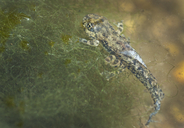|
Pseudacris cadaverina (Cope, 1866)
California Treefrog, California Chorus Frog Subgenus: Hyliola | family: Hylidae subfamily: Hylinae genus: Pseudacris |
| Species Description: Cope, E. D. (1866). "On the structures and distribution of the genera of the arciferous Anura." Journal of the Academy of Natural Sciences of Philadelphia. Series 2(6), 67–112. | |
|
Taxonomic Notes: Duellman, Marion, and Hedges (2016, http://doi.org/10.11646/zootaxa.4104.1.1) proposed resurrecting the unused name Hyliola for western North American tree frogs Pseudacris regilla and P. cadaverina. Faivovich et al. (Faivovich J, Pereyra MO, Luna MC, Hertz A, Blotto BL, Vásquez-Almarzán CR, McCranie JR, Sánchez DA, Baêta D, Araujo-Vieira K, Köhler G, Kubicki B, Campbell JA, Frost DR, Wheeler WC, and Haddad CFB. 2018. On the monophyly and relationships of several genera of Hylini (Anura: Hylidae: Hylinae), with comments on recent taxonomic changes in hylids. South American Journal of Herpetology 13:1–32.) says: "All results published in the last 12 years obtained the P. cadaverina + P. regilla clade as the sister taxon of the remaining species of Pseudacris. As such, the resurrection of Hyliola is both congruent with our phylogenetic knowledge, and optional on the same grounds. Given the optional nature of the recognition of Hyliola and the lack of any substantial discussion as to its taxonomic utility, we see no reason to follow it." |
|
 © 2010 Andreas Kettenburg (1 of 58)
|
|
|
||||||||||||||||||||||||||||





 Map of Life
Map of Life